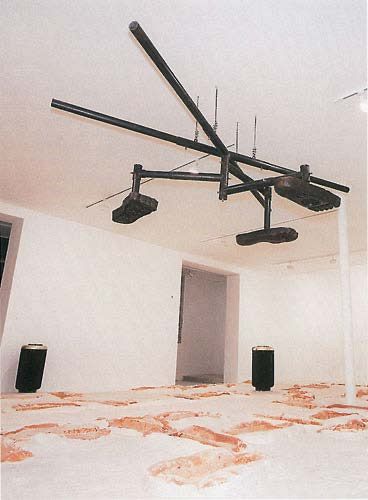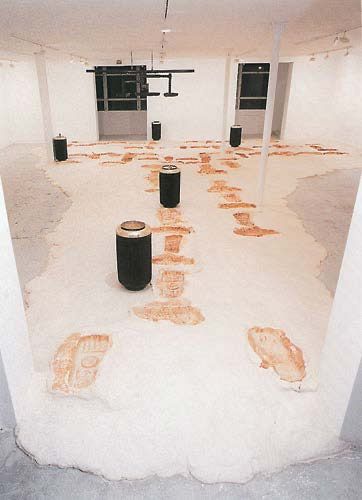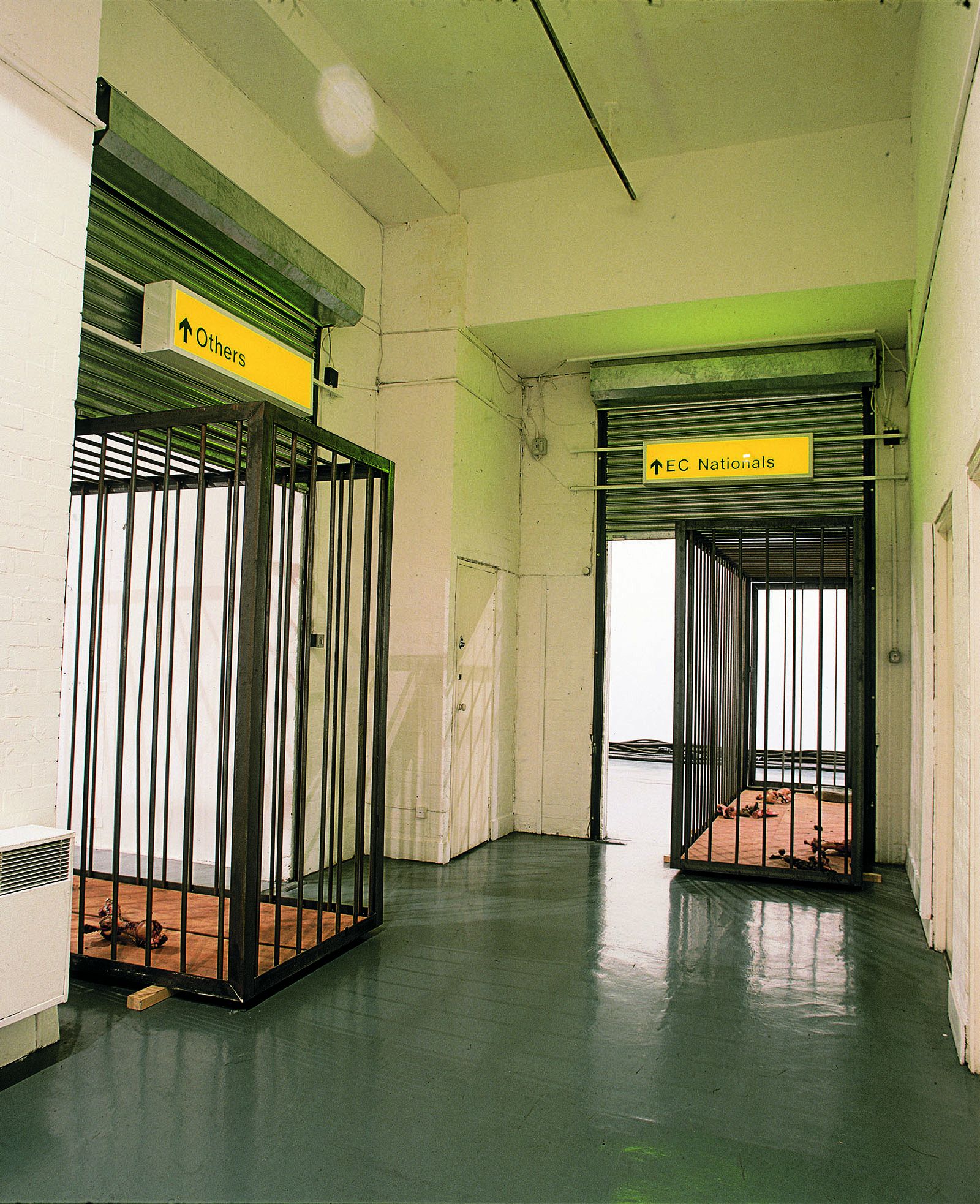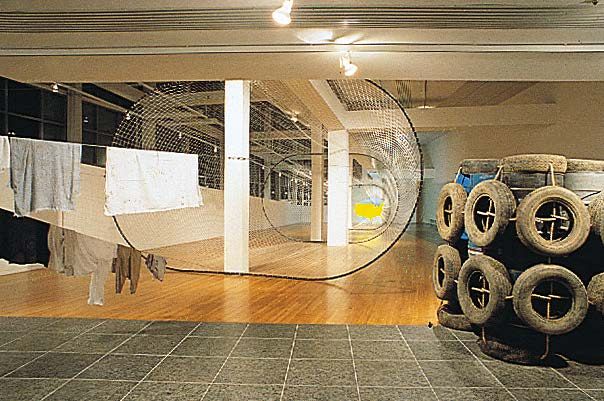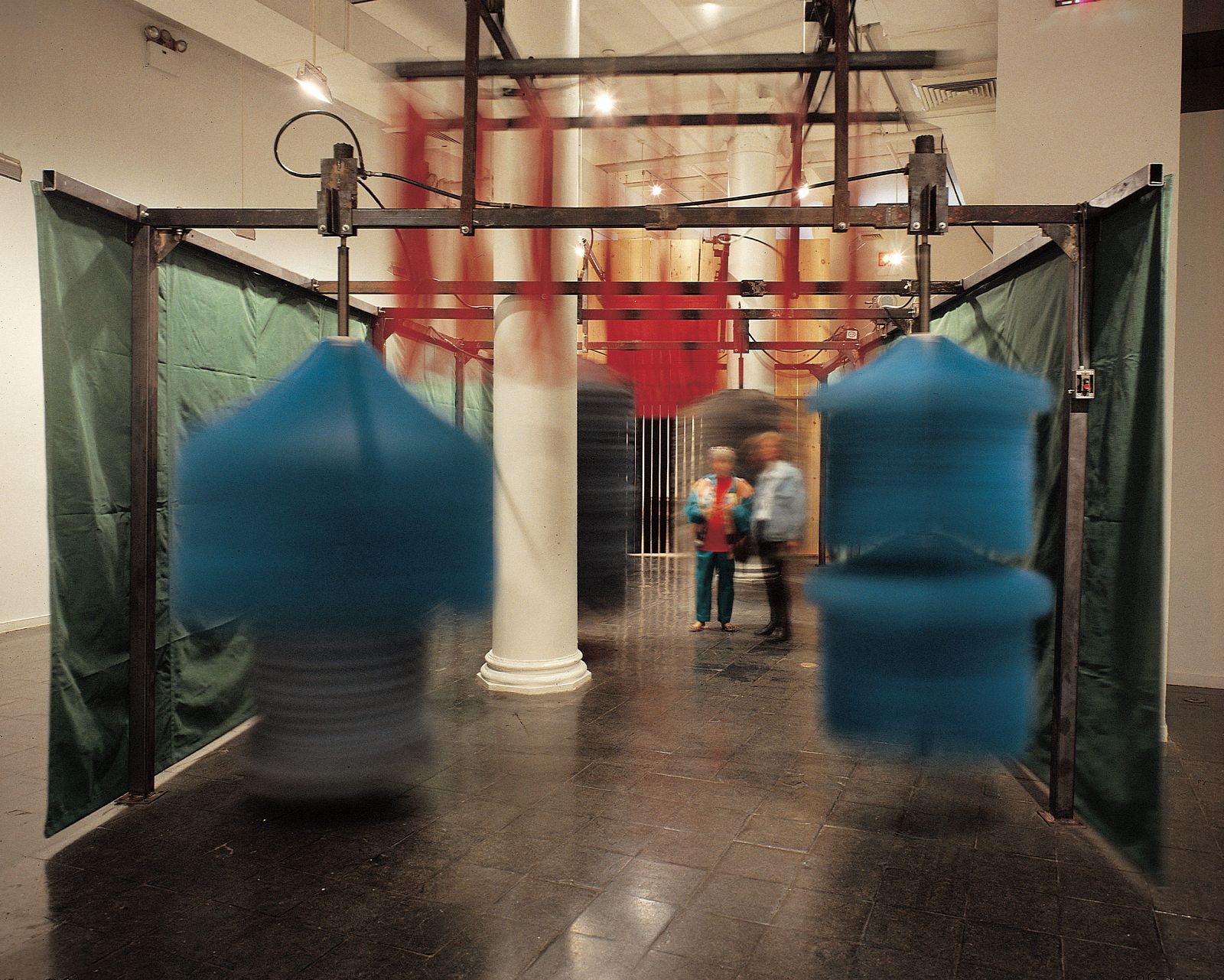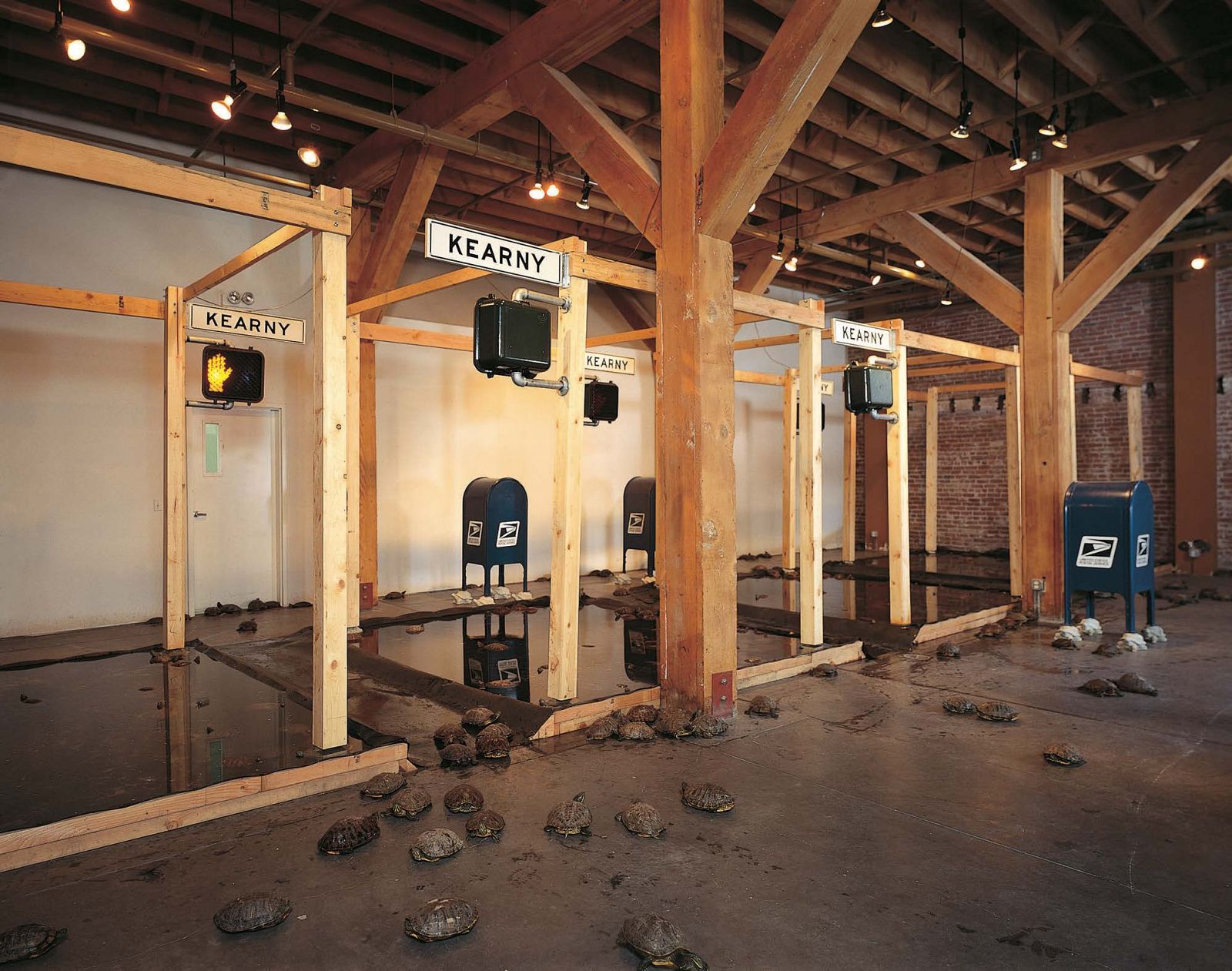Editor’s Note:
This never-before-published text comes from the personal archive of curator Hou Hanru. On the second anniversary of Huang Yong Ping’s passing (February 18, 1954 – October 20, 2019), this essay offers a chance to revisit this important artist and an echo of the Chinese avant-garde tradition.
Three Steps, Nine Footprints was an installation work that Huang Yong Ping created in Marseille in 1996. Relating to the frequent terrorist attacks that took place in France at the time, his work mixed multiple religious traditions and everyday objects, juxtaposing seemingly contradictory ideologies and intellectual standpoints within the same time and place. This work echoes the physical location in which it was presented—the culturally mixed and historically complex southern French port of Marseille—but it also offers the viewer a space in which to participate in understanding, processing, and reflecting reality. During Xiamen Dada (1986), Huang emphasized a suspicion of linguistic signification and revealed cultural misinterpretations and their political import. After he moved to France, he offered his unique viewpoint and perspective as an immigrant artist on a rapidly changing post-war and post-colonial present and future, challenging “normal” relationships among accepted ideas, art, and society. He also employed non-Western cultural references to critique and intervene in a Western-centric artistic and political system. Here, Hou Hanru, one of Huang’s close collaborators, compares the artist to a truly dynamic “writer” (or “écrivain” in Barthes’ terms) who dislodges the mythical structures of our language and thought, while also loosening larger systems of power. Huang Yong Ping takes feedback from historical and cultural moments and uses it to ask broader questions about cultural, political, and religious myths.
(I)
Three Steps, Nine Footprints, a recent installation work by Huang Yong Ping produced in the Ateliers d’Artistes de la Ville de Marseille this March, is as magical as its name suggests. In the 120-square-meter exhibition space, Huang poured a thick layer of plaster on the floor, creating a kind of continental topography, reminiscent of Robert Smithson’s exciting Glue Pour (1969) and Asphalt Rundown (1969). Before the plaster had fully set, Huang used an unusual machine with three cast-iron feet (80 x 35 cm) bearing the footprints of Buddha, Jesus Christ, and the prophet Muhammad suspended on a frame. These three feet, each representing a major world religion, was stamped into the plaster “continent” at different depths according to the methods prescribed in the Steps of Yu (Yubu) from the Daoist classic Master Embracing Simplicity (Baopuzi). After it was used to make the imprints, the structure was suspended from the ceiling, such that the three feet appeared to fly, but also ready to stomp down on the viewer. In the grid formed by the intersection of these three large footprints, Huang inserted seven public garbage cans, which were sealed with Algerian flatbread, a pressure cooker lid, and other everyday objects. All of this is part of a dramatic performance, which truly embodies the original significance of installation art: installation as a process that emphasizes the constant movement, formation, and expansion of space, or more simply, installation as a verb (to install).
(II)
In 1996, the layering of religious images (footprints) on a continent and the sealed garbage cans would certainly have evoked memories of the wave of terrorism that had sent France into a panic several months earlier. In fact, the police were still on high alert to prevent the next terrorist attack and Vigipirate1Editor’s note: Vigipirate is France’s national security alert system; the system’s highest level of alert was in force. was still in force. The situation between France and the Algerian terrorists has continued to worsen and acts of violence are still occurring. At the time of writing, seven French monks in Algeria had just been murdered by the Armed Islamic Group (GIA), which outraged people worldwide. In a regional political climate shaped by territorial conflicts and religious resistance, this wave of terrorism was, from the beginning, the most urgent and serious issue that the news media conveyed to the public, to the extent that it became a mythical part of everyday life. It eventually became ubiquitous; the more everyday it was, the more mythologized it became. As this happened, it is worth contemplating the ways in which the government used its political power (when combined with the logic and methods of the news media) to mythologize terrorist acts, which resulted in the myth of counterterrorism that served its political interests. This process transforms social crisis into a chance to gain power—a classic political strategy.
As Roland Barthes noted, myth does not invent fact; it deforms fact so that it can be used by a given ideology.2Roland Barthes, Mythologies, trans. Annette Lavers (New York: Jonathan Cape, 1972), 232. The shaping of myth benefits from the ingenious use and deformation of communal symbols in society, particularly those that leave a strong impression; this strategy has been used to characterize terrorist events from a single perspective. These public symbols and forms include all aspects of police counterterrorism efforts: the increased police presence, the re-establishment of border controls, the routine security checks in public places, and the circulation of wanted posters. There is one other element that cannot be overlooked: because the bomb in the center of Paris was placed in a public garbage can, the police decided to seal public garbage cans in Paris, Lyon, Marseille, and other major cities. As a result, garbage was often thrown directly onto the streets, and an everyday object that was once purely practical was deformed into a symbol of counterterrorism. The immediacy of this imagery almost permits people to forget the diverse methods employed by terrorists and the various possibilities that public spaces offer for their activities. In other words, as the image of the sealed garbage can was firmly established, the symbolic meaning of the object was emphasized to the point of becoming myth, and the origins and development of the terrorist acts could almost be set aside. Terrorism is the product of contradictions in the colonial history of France (and the West), and particularly the complex connections between Western and non-Western countries in the post-colonial era. Mythical imagery attempts to simplify this complexity, and it helps to establish the legitimacy and necessity of the government’s Western-centric ideology and actual political and economic machinations. This mythologized imagery embodies the inversion of myth that Barthes noted in his analysis of bourgeois ideology; it tries its utmost to have people believe that the structure and order of Western power was being threatened with destruction by an outside enemy and the existence of a specific Other. Here, Huang’s garbage cans sealed with everyday items used by Arab peoples draw us into a continent on which three religions coexist, which not only suggests cultural resistance and conflict, but also humorously shows the true colors of that political myth by pushing it to a logical extreme.
(III)
Terrorist acts are certainly a moral and social issue that today’s “civilized” society must confront; their sudden, “explosive” effect often adds a dramatic tinge. Of course, terrorists also mythologize these acts to achieve political and ideological objectives, but at the same time, terrorist attacks are not accidental; they are closely related to a specific ethnic, regional, national, or even global issue; terrorist acts are often the direct or indirect consequence of these historical issues. In certain circumstances, terrorist acts can be interpreted as a way of expressing something—whether justified or not—that is not accepted or actively repressed, and as such, cannot be expressed in any other way within the current structure of “civilized” society. For example, the terrorist attacks that happened in France last year are certainly related to past entanglements, current conflicts, and behind-the-scenes transactions between former colonizer France and former colony Algeria. With this in mind, we can see that the government’s counterterrorism myth and the terrorists’ myth have something in common, and this results in the replacement of a complex reality with a moral myth, a simple Hollywood-style opposition between the good and the evil, the attackers and the victims, the enemy and the people.
If we truly want to understand the reason for these violent attacks and clearly distinguish between good and evil, then we invariably have a moral responsibility to demystify the myths of terrorism and counterterrorism, consistent with the moral imperative that compelled Barthes to write Mythologies to resist and neutralize the dominating force of bourgeois ideology in modern societal discourse and literature.
As a Chinese artist living in the West, demystification is precisely what Huang Yong Ping attempts to do in Three Steps, Nine Footprints. He reveals the ways in which official myths are produced, but he also unearths their historical origins. Through footprints representing three major religions pressed into the same continent, he reminds people of these historical origins and draws a conclusion from the heights of law or the fates of things.
Barthes wrote, “Truth to tell, the best weapon against myth is perhaps to mythify it in its turn, and to produce an artificial myth: and this reconstituted myth will in fact be a mythology. Since myth robs language of something, why not rob myth?”3Barthes, 135. Huang Yong Ping fully understood this strategy, so he stole an allusion to myth from Chinese history that seems unrelated to Western reality: the Steps of Yu or the idea of “three steps, nine footprints.” When he uses this idea to resist the myths of terrorism and counterterrorism, it invades the territory of Western myth. He layers one myth on top of another, dissolving it and re-mystifying it to achieve demystification. In these specific circumstances, terrorism can be an expression of suppressed voices, and discourses from other cultures like the Steps of Yu—which have mythical qualities—can give voice to an alternative culture in this “civilized” society. Here, Huang is juxtaposing different alternative and mainstream discourses, such that they collide with and resist one another, then dissolve one another. The myths of terrorism and counterterrorism are built on what Barthes characterizes as a reduction in its historical essence, which makes it empty, rational, and natural. The invasion of alternative discourse attacks and destroys this rational order, creating the chaos of the mingled footprints of men and gods, the coexistence and conflict between different religions and cultures, and the intersection of colonial history and post-colonialist reality, which Huang Yong Ping emphasizes with his three feet that walk together. This chaotic situation is the beginning of the complete deconstruction of these myths.
Even as Huang unearths the historical origins of these myths, his demystification strategy does not depart from his current reality; his true intention is to focus on reality. The Marseille exhibition of Three Steps, Nine Footprints was not without a basis in reality. Most of last year’s terror attacks took place in Paris, but the direct reason for Huang’s choice may have been the hijacking of an Air France flight by GIA on Christmas 1994, which ended at Marseille airport. The city of Marseille is located on the Mediterranean coast, so it has always been a base of operations for French colonial endeavors. The city is a mixture of races, religions, and cultures. It has frequent contact with the former Algerian colony, and today it is a typical post-colonial city. Marseille is an important link in the relationship between France and Algeria. For more than six months, symbolic images of government counterterrorism efforts, such as police patrols, inspections, closures, and garbage cans, have been part of everyday life in Marseille. In this context, Huang’s work gets right to the point, showing the city’s more universal yet multi-faceted significance. This focus on the present and its political mythologies have been an important part of his recent work in Western contexts, as demonstrated by Passage (1993) at the Glasgow Gallery of Modern Arts, Human-Snake Plan (1993) at the Wexner Centre, Chinese Hand Laundry (1994) at the New Museum, and Kearny Street (1994) at Capp Street Project. Three Steps, Nine Footprints in Marseille more successfully fuses the past and present, thereby giving his demystification strategy more depth.
We have already noted that Huang Yong Ping’s installations emphasize the fluid process by which the work is formed and the space expanded, as well as a range of unimaginable possibilities. This openness transforms the work into a kind of performance. The allusion to the Steps of Yu or the imagery of three steps leaving nine footprints acts as demystification in a cultural sense, but it is also a way to create an appropriate and effective language after that demystification. The Steps of Yu comes from a Daoist ceremony recorded in Master Embracing Simplicity, and it generally implies a miracle, something beyond the ordinary. Specifically, in the story, the ancient sage Yu walked with a limp and leaned on a staff, so he left three “footprints” wherever he went. With every three steps, he would leave nine footprints. This unusual limp gave him the supernatural power to control the Yellow River. Daoism would later adopt this phrase as an allusion for all miracles and codify the Steps of Yu into ceremonial footwork, which in turn suggests the dialectic of a contradictory union and transformation of behavioral rules (footwork) and chance (freedom). While comprehending this dialectic, Huang’s citation of the Steps of Yu is an attempt to highlight the openness and fluidity of his work, as well as the path to demystification that he has built, but he also uses the unconventional (irrational?) image of a limp to show that this path abounds in unforeseeable risks. That limp could very likely cause us to take the wrong path and get lost, but it could also lead to magical encounters that we could not have imagined. This risky process produces a space in which one myth meets another and is deconstructed. More importantly, this process takes the meta-language that is used to abstract myth and returns it to the truth, to a language object. As a result, viewers and the artist alike can participate in this demystification process. This act of participation is demystification itself, and not just a symbolic change. The intervention of the body changes the relationship between language and object, which in turn fundamentally alters the structure of language itself. Its ultimate goal is the destruction of linguistic signification and categorization methods and structures that create a myth and the political power systems that they represent. As Roland Barthes notes, this is an operational language, a kind of political language that intervenes in and changes the object.4Barthes, 145.
It is precisely by using this operational language to see creation—which Barthes calls “writing”—as action or performance that a person working in the art can become a true artist—Barthes’ “writer.”
Paris, 1996
Translated from the Chinese by Bridget Noetzel.
Hou Hanru is an international art curator and critic. He is the Artistic Director of the MAXXI in Rome and the Consulting Curator for The Robert H. N. Ho Family Foundation Chinese Art Initiative at the Guggenheim Museum in New York. He has taught and lectured at Rijksakademie van Beeldende Kunsten in Amsterdam, worked as a consultant and advisor at Walker Art Center, and at San Francisco Art Institute as Director of Exhibitions and Public Program and Chair of Exhibition and Museum Studies.
Bridget Noetzel is a translator, editor, and art consultant based in Hong Kong. She received a BA in both Chinese Language and the History of Art from Yale University. Since 2009, she has worked with galleries and artists in Beijing and Hong Kong, and she has translated and edited for major publications, institutions, and auction houses. In 2017, she co-founded the Asia Photography Project. She was the translator for Yi Ying’s history of modern Chinese art, entitled Art and Artists in China 1949-Present (Cambridge University Press, 2018).
